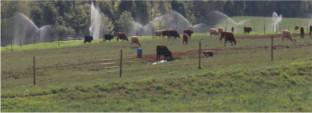Agronomy for Sustainable Development ( IF 7.3 ) Pub Date : 2023-01-05 , DOI: 10.1007/s13593-022-00857-6 Jefferson Felipe Cavazzana , Wagner Paris , Marcos Luis Molinete , Alexandre Augusto Auache Filho , Olmar Antônio Denardin Costa , Adalberto Luiz de Paula , Fabiana Matielo de Paula , Luis Fernando Glasenapp de Menezes

|
Increasing productivity and resource efficiency through sustainable intensification of grazing systems impose new challenges on crops and livestock. The sustainability of world agriculture is threatened by the degradation of ecosystem services anthropogenic interventions such as reduced biological diversity, water and air pollution, and loss of soil quality. The search for technologies that increase animal productivity with economic and environmental sustainability is necessary. The aim was to determine whether productive systems based on African Bermuda grass, overseeded in rows with annual ryegrass and black oat, would present better beef cattle performance by irrigation and/or inclusion of forage legumes in the grazing systems. We used 72 steers, 24 in each of the 3 years of evaluation, distributed in 12 paddocks under rotational stocking. Each paddock had four sub-paddocks. The experiment was completely randomized in a 2 × 2 factorial arrangement, using irrigation and legumes as factors. Production and chemical composition of pastures and animal performance were evaluated for 3 years in winter, spring, and summer. The irrigation provided promising results in spring, with a higher stocking rate (2194 vs 1254 kg/ha) and live weight gain per area (5.24 vs 2.81 kg/ha/day) in the second year due to water restriction. The forage legumes with irrigation provided a higher average daily gain in the summer than the non-irrigated pasture with legumes. Here we show for the first time that in long-term results (3 years), the pastures with legumes showed a high live weight gain per area (1556 vs 1452 kg/ha/year), and in the third year, the highest difference for the stocking rate in the summer (4134 vs 3311 kg/ha). Legumes or irrigation do not change the pasture’s nutritional compounds. The use of forage legumes benefits the grazing system with long-term results. Irrigation, conversely, allows for positive responses during periods of water deficit.
中文翻译:

黑燕麦和一年生黑麦草复播的非洲百慕大牧草上的肉牛性能:增加灌溉和温带豆类的影响
通过放牧系统的可持续集约化提高生产力和资源效率对作物和牲畜提出了新的挑战。世界农业的可持续性受到生态系统服务退化的人为干预的威胁,例如生物多样性减少、水和空气污染以及土壤质量下降。有必要寻找能够提高动物生产力并具有经济和环境可持续性的技术。目的是确定基于非洲百慕大草的生产系统,与一年生黑麦草和黑燕麦一起播种,是否会通过灌溉和/或在放牧系统中加入草料豆类来提高肉牛的生产性能。我们使用了 72 头小公牛,在 3 年的评估中每年 24 头,在轮流放养下分布在 12 个围场中。每个围场有四个子围场。实验以 2 × 2 因子排列完全随机化,使用灌溉和豆类作为因子。在冬季、春季和夏季对牧场的产量和化学成分以及动物生产性能进行了为期 3 年的评估。灌溉在春季取得了可喜的成果,由于限水,第二年的放养率(2194 比 1254 公斤/公顷)和单位面积活重增加(5.24 比 2.81 公斤/公顷/天)更高。灌溉豆科牧草在夏季比非灌溉豆科牧草提供更高的平均日增重。在这里,我们首次表明,在长期结果(3 年)中,种植豆类的牧场单位面积活增重较高(1556 对 1452 公斤/公顷/年),在第三年,夏季放养率差异最大(4134 对 3311 公斤/公顷)。豆类或灌溉不会改变牧场的营养成分。饲草豆类的使用有利于放牧系统的长期结果。相反,灌溉允许在缺水期间做出积极反应。



























 京公网安备 11010802027423号
京公网安备 11010802027423号